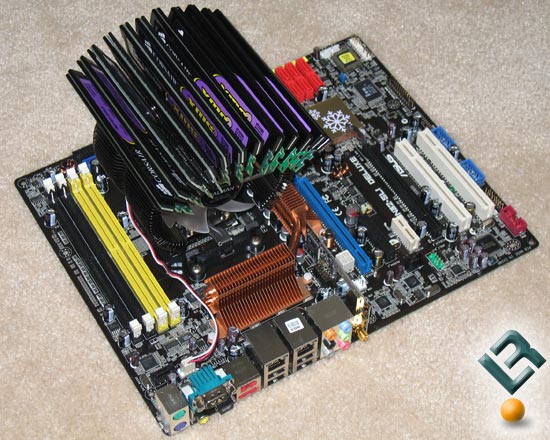Corsair PC2-6400C3 Meets AMD’s AM2 Processors
Sometimes Memory Can Be Tricky
Editor’s Note: Just recently I have been spending a ton of time checking out the just released AMD AM2 processors memory controller and the results have been pretty amazing. This article is the result of what happens when you have a ton of memory and a new platform that has awesome memory potential. Sit back and relax while we take a look at what memory settings perform best on our test platform, but beware the memory heatsink pictured below. (yes, I’ve finally lost it)

Now that AMD’s AM2 processors have been unleased into the wild, AMD users now have to make the transition over to DDR2 memory as DDR1 modules will no longer fit into the DIMM slot or do the job needed. I noticed a number of publications and enthusiasts refer to the reference clock generator as the “front-side bus” frequency, which is starting off wrong as AMD does not have a front-side bus. AMD has a reference clock that generates a signal which serves as the source signal to drive all the components on the motherboard. That reference clock runs at 200MHz. The CPU is driven by a whole multiplier of that reference signal. This is why AMD stopped using half-multipliers on their Athlon 64 processors. This is also why AMD A64 processors have the 200MHz incremental jumps in frequency from processor to processor. Likewise, the memory divisor uses whole numbers. Here is how the frequency of a CPU and the memory is figured on AMD platforms:
reference clock x multiplier = processor/memory controller speed / divisor = memory DIMM speed
First off, the reference clock is always 200MHz. Raising this number overclocks the entire motherboard and therefore not only voids your AMD warranty, it also will cause instability depending on which component on the motherboard stops functioning first because of the overclock. With that said here’s an example:
FX-62 Example:
200MHz (reference clock) x 14 (set by FX-62 CPU) = 2800MHz (CPU and memory controller speed) / 7 = DDR2-PC6400 running @ 400MHz
-or-
X2 4800+ Example:
200MHz (reference clock) x 12 (set by X2 4800+CPU) = 2400MHz (CPU and memory controller speed) / 6 = DDR2-PC6400 running @ 400MHz
Because whole-step multipliers and divisors (as opposed to half-steps like “6.5”) are used you’ll notice that AMD64 processors run at frequencies that are multiples of 200. You will also note something about the speed at which memory is run. Because DDR2 runs at 400MHz, every other frequency speed isn’t evenly divisible by 400. For instance, here is what you get with X2 5000+:
X2 5000+ Example:
200MHz (reference clock) x 13 (set by X2 5000+ CPU) = 2600MHz (CPU and memory controller speed) / 7 = DDR2-PC6400 running @ 371MHz
Note that the 2.6GHz frequency isn’t divisible by a smaller divisor without overclocking the memory (a divisor of “6” would overclock memory at 433MHz).
So, let me get this right… If I spend more money and buy the faster clocked X2 5000+, my memory throughput will be lower than the X2 4800+ because the divisor used memory uses whole-step multipliers? Yes, you got that right! While running at DDR2 742MHz vs. DDR2 800MHz results in a decrease in memory bandwidth it might make people think twice before what CPU they buy. If you want your memory controller running at a true 800MHz, then stay away from the odd clock multiplier CPUs (X2 5000+, 4400+ and 4200+)!
Today we take a look at the importance memory plays when using AMD’s AM2 platforms. Our goal in this article is to find the best memory settings for gaming and our benchmark tool is DOOM 3.

Comments are closed.